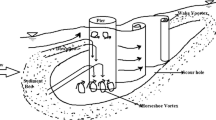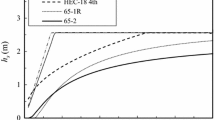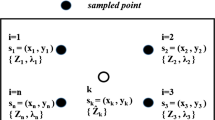Abstract
Effective estimation of scour parameters downstream ski-jump buckets is very important for risk management plan. This paper presents a new method for prediction of the depth, length, and width of the scour hole downstream ski-jump buckets based on granular computing (GrC) technique. This method employs various independent hydraulic, morphologic, and geotechnical factors to predict dependent scour parameters. Evaluation of the results indicated that the dependent scour parameters are affected more by the discharge, falling height, and mean sediment size and less by the lip angle of the bucket. Analyses of the obtained results demonstrated the high accuracy of the GrC, as the predicted values were in good agreement with the observations. Furthermore, statistical equations were derived based on the multiple linear regressions (MLR) to model the relationship between the scour parameters. Despite our expectations, the results of MLR, as a simple model, were excellent as compared to GrC. MLR results were also superior to those of well-known empirical equations presented to date. The GrC gives the best performance for the prediction of scour parameters; however, MLR model is also suggested for any real cases because it can be more applicable by practical engineers than GrC as a black box model.




Similar content being viewed by others
References
Agalbjörn S, Koncar N, Jones AJ (1997) A note on the gamma test. Neural Comput & Applic 5(3):131–133. doi:10.1007/BF01413858
Alias NA, Mohamed TA, Ghazali AH, Megat-Mohd-Noor MJ (2008) Impact of take off angle of bucket type energy dissipater on scour hole. Am J Appl Sci 5(2):117–121
Azmathullah HM, Deo MC, Deolalikar PB (2005) Neural networks for estimation of scour downstream of ski-jump bucket. J Hydraul Eng 131(10):898–908. doi:10.1061/(ASCE)0733-9429(2005)131:10(898)
Azmathullah HM, Ghani AAB, Zakaria N, Hin LS, Kiat CC, Siang LC, Hasan ZA (2008) Genetic programming to predict ski-jump bucket spillway scour. J Hydrodynam B 20(4):477–484. doi:10.1016/S1001-6058(08)60083-9
Cabrerizo FJ, Herrera-Viedma E, Pedrycz W (2015) A method based on PSO and granular computing of linguistic information to solve group decision making problems defined in heterogeneous contexts. Eur J Oper Res 230(3):624–633. doi:10.1016/j.ejor.2013.04.046
Chanson H (2004) The hydraulic of open channel flow. Elsevior, New York
Chen B, Pellicer S, Tai PC, Harrison R, Pan Y (2009) Novel efficient granular computing models for protein sequence motifs and structure information discovery. Int J Comput Biol Drug Des 2(2):168–186. doi:10.1504/IJCBDD.2009.028822
Dawson CW, Wilby RL (1999) A comparison of artificial neural networks used for river flow forecasting. Hydrol Earth Syst Sci 3(4):529–540. doi:10.5194/hess-3-529-1999
Goyal MK, Ojha CSP (2011) Estimation of scour down stram of a ski jump bucket using support vector and M5 model tree. Water Resour Manag 25:2177–2195. doi:10.1007/s11269-011-9801-6
Guven A (2011) A multi-output descriptive neural network for estimation of scour geometry downstream from hydraulic structures. Adv Eng Softw 42(3):85–93. doi:10.1016/j.advengsoft.2010.12.005
Guven A, Gunal M (2008) Prediction of scour downstream of grade-control structures using neural networks. J Hydraul Eng 134(11):1656–1660. doi:10.1061/(ASCE)0733-9429(2008)134:11(1656)
Hong WC, Pai PF (2007) Potential assessment of the support vector regression technique in rainfall forecasting. Water Resour Manag 21(2):495–513. doi:10.1007/s11269-006-9026-2
Hooshyaripor F, Noori R (2013) Using support vector machine to predict scour hole dimensions downstream of a ski-jump bucket. Iran J Water Environ Eng 1(1):35–45
Jahromi S, Nasserian H (2010) Effect of tailwater depth on the scour downstream of falling jets. Scour and Erosion, pp 688–696. doi:10.1061/41147(392)67
Jain A, Indurthy SKVP (2003) Comparative analysis of event based rainfall–runoff modeling techniques-deterministic, statistical, and artificial neural networks. J Hydrol Eng 8:93–98. doi:10.1061/(ASCE)1084-0699(2003)8:2(93)
Mason PJ, Arumugan K (1985) Free jet scour below dams and flip bucket. J Hydraul Eng 111(2):220–235. doi:10.1061/(ASCE)0733-9429(1985)111:2(220)
Moghaddamnia A, Ghafari-Gousheh M, Piri J, Amini S, Han D (2009) Evaporation estimation using artificial neural networks and adaptive neurofuzzy inference system techniques. Adv Water Resour 32(1):88–97. doi:10.1016/j.advwatres.2008.10.005
Najafzadeh M, Bonakdari H (2016) Application of a neuro-fuzzy GMDH model for predicting the velocity at limit of deposition in storm sewers. J Pipeline Syst Eng Pract. doi:10.1061/(ASCE)PS.1949-1204.0000249
Najafzadeh M, Barani GA, Hessami-Kermani MR (2014) Group method of data handling to predict scour at downstream of a ski-jump bucket spillway. Earth Sci Inf 7(4):231–248. doi:10.1007/s12145-013-0140-4
Noori R, Hooshyaripor F (2014) Effective prediction of scour downstream of Ski-jump buckets using artificial neural networks. Water Resour 41(1):8–18. doi:10.1134/S0097807814010096
Noori R, Karbassi AR, Moghaddamnia A, Han D, Zokaei-Ashtiani MH, Farokhnia A, Ghafari-Goushesh M (2011) Assessment of input variables determination on the SVM model performance using PCA, Gamma test, and forward selection techniques for monthly stream flow prediction. J Hydrol 401(3–4):177–189. doi:10.1016/j.jhydrol.2011.02.021
Noori R, Deng Z, Kiaghadi A, Kachoosangi F (2015) How reliable are ANN, ANFIS, and SVM techniques for predicting longitudinal dispersion coefficient in natural rivers? J Hydraul Eng. doi:10.1061/(ASCE)HY.1943-7900.0001062
Pagliara S, Hager WH, Minor HE (2004) Plunge pool scour in prototype and laboratory. In: Yazdandoost F, Attari J (eds) Hydraulics of dams and river structures. Taylor & Francis Group, London, pp 165–172
Rahimikhoob A (2016) Comparison of M5 model tree and artificial neural network’s methodologies in modelling daily reference evapotranspiration from NOAA satellite images. Water Resour Manag 30(9):3063–3075. doi:10.1007/s11269-016-1331-9
Rajaratnam N, Mazurek K (2003) Closure to “Erosion of sand by circular impinging water jets with small tailwater”. J Hydraul Eng 129(3):225–229. doi:10.1061/(ASCE)0733-9429(2004)130:7(725)
Saberi M, Mirtalaie MS, Hussain FK, Azadeh A, Hussain OK, Ashjari B (2013) A granular computing-based approach to credit scoring modeling. Neurocomputing 122(25):100–115. doi:10.1016/j.neucom.2013.05.020
Safavi HR, Esmikhani M (2013) Conjunctive use of surface water and groundwater: application of support vector machines (SVMs) and genetic algorithms. Water Resour Manag 27(7):2623–2644. doi:10.1007/s11269-013-0307-2
Samadi M, Jabbari E, Azamathullah HM (2014) Assessment of M5′ model tree and classification and regression trees for prediction of scour depth below free overfall spillways. Neural Comput Applic 24(2):357–366. doi:10.1007/s00521-012-1230-9
Samadi M, Jabbari E, Azamathullah HM, Mojallal M (2015) Estimation of scour depth below free overfall spillways using multivariate adaptive regression splines and artificial neural networks. Eng Appl Comp Fluid 9(1):291–300. doi:10.1080/19942060.2015.1011826
Sheikhian H, Delavar MR, Stein A (2015a) Predictive modelling of seismic hazard applying naïve Bayes and granular computing classifiers. Procedia Environ Sci 26:49–52. doi:10.1016/j.proenv.2015.05
Sheikhian H, Delavar MR, Stein A (2015a) Integrated estimation of seismic physical vulnerability of Tehran using rule based granular computing. In: Zlatanova S, Sithole G, Nakagawa M, Zhu Q (eds) Archives of the photogrammetry, remote sensing and spatial information sciences. La Grande Motte, France, p 187–193. doi:10.5194/isprsarchives-XL-3-W3-187-2015
Sreeja CKP (2012) Evaluation of selected equations for predicting scour downstream of ski-jump spillway using laboratory and field data. Eng Geol 129:98–103. doi:10.1016/j.enggeo.2012.01.014
Tayfur G, Singh VP (2011) Predicting mean and bankfull discharge from channel cross-sectional area by expert and regression methods. Water Resour Manag 25(5):1253–1267. doi:10.1007/s11269-010-9741-6
Veronese A (1937) Erosion of a bed downstream from an outlet. Colorado A & M College, Fort Collins
Vesalian RM (2006) Investigation of scour downstream of dam by physical model. Dessertation, Science and Research Branch, Islamic Azad University, Iran
Wang M, Hu NQ, Qin GJ (2013) A method for rule extraction based on granular computing: application in the fault diagnosis of a helicopter transmission system. J Intell Robot Syst 71(3):445–455. doi:10.1007/s10846-012-9793-3
Wittler RJ, Annandale GW, Abt SR, Ruff JF (1998) New technology for estimating plunge pool or spillway scour. In: Lexington KY (ed) Proceeding of annual conference of the association of state safety officials. Las Vegas, USA, p 755–766
Yao YY (2004) A partition model of granular computing. In: James FP (ed) Transactions on rough sets I, LNCS. Springer, Berlin, pp 232–253
Yao YY, Yan M (2007) ICS: An interactive classification system. In: Kopti Z, Wu D (eds) Advances in artificial intelligence, LNCS. Springer, Berlin, pp 134–145
Author information
Authors and Affiliations
Corresponding author
Rights and permissions
About this article
Cite this article
Noori, R., Sheikhian, H., Hooshyaripor, F. et al. Granular Computing for Prediction of Scour Below Spillways. Water Resour Manage 31, 313–326 (2017). https://doi.org/10.1007/s11269-016-1526-0
Received:
Accepted:
Published:
Issue Date:
DOI: https://doi.org/10.1007/s11269-016-1526-0




